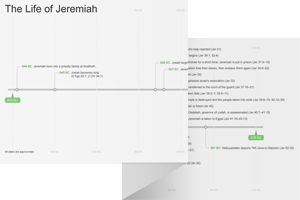13:1–11 Jeremiah performs a symbolic action designed to illustrate how Israel’s once intimate relationship with Yahweh had been spoiled. The narrative reports Yahweh’s instructions for the action, the prophet carrying out the action, and an explanation of the significance of the action. |
 Symbolic Actions of the Prophets Table
Symbolic Actions of the Prophets Table
13:1 a loincloth of linen The use of linen is significant since priestly garments were to be made only of linen (Lev 16:4). If this article of clothing is an undergarment, the symbolism may suggest a level of intimacy.
you must not place it in water The command to keep the garment out of water is enigmatic and open to a variety of interpretations.
13:4 to the Euphrates The location of the Euphrates (perath) affects the understanding of Jeremiah’s action. Normally, the Hebrew word used here, perath, refers to the Euphrates River, which was more than 350 miles away—a journey of six to eight weeks (one way). The location was symbolic of the Babylonians as those who would ruin the land of Judah.
13:6 after a long time A significant amount of time may have passed before Jeremiah’s return trip, but the precise timing is not important for the symbolism. Enough time passed for the garment to be ruined.
13:7 the loincloth was ruined The location and the length of time are less important than the fact that the exposure to the rocks, dirt, and weather ruined the cloth.
13:9 the pride of Judah The garment is revealed to be symbolic of Judah. Just as the cloth was ruined and made unusable, so the people of Judah have brought ruin on themselves through their rebellion and idolatry.
13:11 loincloth clings to the loins of See note on Jer 13:1. The analogy here comparing the garment with the prestige and glory of the one wearing it suggests it is an externally visible garment, like a sash around the waist.
a people, and a name Yahweh had invested a great deal in Israel as His people, and His reputation was closely tied to their fate. See 33:9.
13:12–14 An oracle of judgment, introduced by an enigmatic saying about jars of wine, is pronounced against the leaders of Judah and all the people. The saying likely expresses a popular proverb or aphorism. |
13:12 Every jar must be filled with wine The same consonants denote the Hebrew words for “jar” (nevel) and “fool” (naval). The wordplay recasts the proverb as “every fool will be filled with wine.” This is either a comment on the triteness of the proverb or a critique of complacency and misplaced confidence.
13:13 all the inhabitants of Jerusalem The judgment includes the kings, prophets, and priests, but it is not primarily an indictment against the leaders; judgment is coming against all Judah.
13:15–27 Jeremiah moves from the pronouncement of judgment in v. 14 to an extended description of the tragedy of exile. This oracle first calls for repentance (vv. 15–17). It then addresses the downfall of the king (vv. 18–19) and highlights how Judah’s idolatry has led to destruction (vv. 20–27). With a focus on both repentance and exile, this oracle may reflect a time after the exile of the king in 597 bc but before the ultimate destruction of Jerusalem and the temple in 586 bc. |
13:18 the king and to the queen mother See 2 Kgs 24:8. Jehoiachin was taken into exile in 597 bc. Jeremiah likely is alluding to the loss of royal power at that time. Most of the ruling class went into exile with Jehoiachin.
13:19 the Negev The region south of Jerusalem, the southern extent of Judah’s territory.
13:20 those coming from the north The invaders. See Jer 1:14 and note.
the flock Alludes to the metaphor of the king as shepherd and the people as his flock. See 10:21 and note.
13:22 Why have these things happened to me? Judah is depicted as playing innocent, questioning the disaster as unjust and inexplicable. Yahweh’s reply indicates they should have known better and should have expected retribution.
your skirts are uncovered A symbol of humiliation and public shame. Being unclothed or stripped metaphorically depicts them being exposed to the judgment of God. See Isa 47:3; Nah 3:5; Lam 1:8.
13:23 or a leopard his spots A rhetorical question emphasizing that some things cannot be changed. Israel’s habitual wickedness is depicted as a deep and unchangeable physical attribute.
13:24 I will scatter them like stubble A standard depiction of judgment by exile. See Lev 26:33.
13:27 Your adulteries, and your neighings, the shameful behavior of your fornications on the hills in the countryside, I have seen your abominations Imagery of idolatry and sexual infidelity are intertwined. Compare Ezek 16:1–58 and note on Ezek 16:15.

|
About Faithlife Study BibleFaithlife Study Bible (FSB) is your guide to the ancient world of the Old and New Testaments, with study notes and articles that draw from a wide range of academic research. FSB helps you learn how to think about interpretation methods and issues so that you can gain a deeper understanding of the text. |
| Copyright |
Copyright 2012 Logos Bible Software. |
| Support Info | fsb |
 Loading…
Loading…

 several months to the Euphrates and back and repeated the trip again later, a literal journey is not necessary to understand the symbolism. A prophetic sign-act was symbolic, and even locations could be symbolized instead of literally visited (see
several months to the Euphrates and back and repeated the trip again later, a literal journey is not necessary to understand the symbolism. A prophetic sign-act was symbolic, and even locations could be symbolized instead of literally visited (see 
